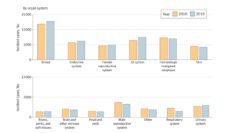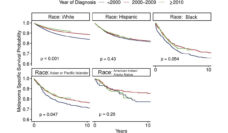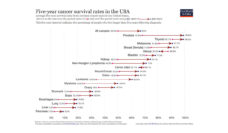Childhood cancer is uncommon. An estimated 9,910 children will be diagnosed with cancer in 2023 in the United States according to the National Cancer Institute. Yet most of us probably know or will know at least one child or family affected by cancer in a young person in our lifetimes. It is heartbreaking.
As with many other illnesses, people of color are less likely to survive cancer than White individuals. Through many research studies, we and other cancer epidemiologists have established that Black children are more likely to die from their cancer than White children. According to the most recent data, the estimated 5-year relative survival rate for Black children was 5.6% lower than for White children.
What factors in Black children’s lives underlie this troubling fact? The answer to this question is important so that we can develop interventions to alleviate or even eliminate this survival disparity between Black and White children. One factor may be related to differences in health care access.
Children receive health insurance through both public and private sources. Medicaid and the Children’s Health Insurance Program (CHIP) provide government-funded health insurance to over half of U.S. children from low socioeconomic backgrounds. Private insurance, often obtained through parental employment, is the other major type of health insurance for children.
We recently published data from a study looking at whether the type of health insurance (private insurance and Medicaid/CHIP) a child had at their cancer diagnosis or initial treatment helps to explain this survival disparity. We analyzed data from the National Cancer Database for 54,558 children and adolescents diagnosed with cancer between 2004 and 2010. This database includes tumor registry data from over 1,500 hospitals and captures 70% of all newly diagnosed cancer cases each year in the United States.
Significant dents in the survival gap will likely come through policies that ensure easy and affordable access to high-quality health care for all children and families.
Our analyses found that Black children and adolescents experience inferior survival compared to White children across both health insurance types. This remained true even after we accounted for differences in socioeconomic status. However, the size of the differences in risk for death varied by type of health insurance coverage. The elevated risk of dying from cancer in Black vs. White children with private insurance was higher than for Black vs. White children enrolled in Medicaid/CHIP.
Specifically, privately insured Black children and adolescents had a 48% higher risk of death than their White counterparts. By comparison, Black children and adolescents enrolled in Medicaid/CHIP had a 30% greater risk of dying. We also found a similar pattern when comparing the survival of White children with all other racial and ethnic groups.
Our findings suggest that White children and adolescents benefit more from private insurance than children and adolescents of color. The possible reasons are still unclear but might relate to differences in the types of private insurance held by White vs. children of color. For example, children of color may be on plans that have higher deductibles, which could create barriers to seeking medical care.
In addition, there could be differences in non-insurance-related factors in children covered by private insurance. These factors could relate to social determinants of health that may impede timely diagnosis and optimal treatment for children of color, including transportation challenges, access to high-quality health care, language barriers, and caregiver education and knowledge about cancer.
We note that there is also a disparity in cancer survival between Black and White children and adolescents with Medicaid/CHIP of 30%. This indicates that simply providing access to care is insufficient to eliminate survival gaps within the Medicaid/CHIP population. They may experience barriers similar to Black children in the privately insured population that impede access to timely diagnosis and optimal treatment.
Additional research is needed to understand how different types of insurance and their costs contribute to this large disparity among children and adolescents with private insurance. In addition, there is a need to understand why the disparity is still present, although to a lesser degree, in children and adolescents with Medicaid/CHIP. Significant dents in the survival gap will likely come through policies that ensure easy and affordable access to high-quality health care for all children and families.
Photo via Getty Images















